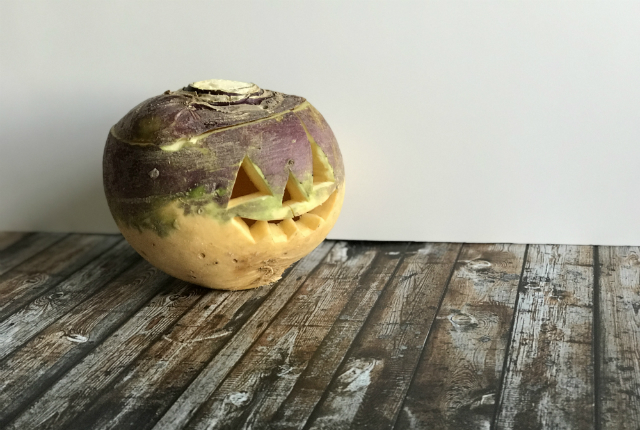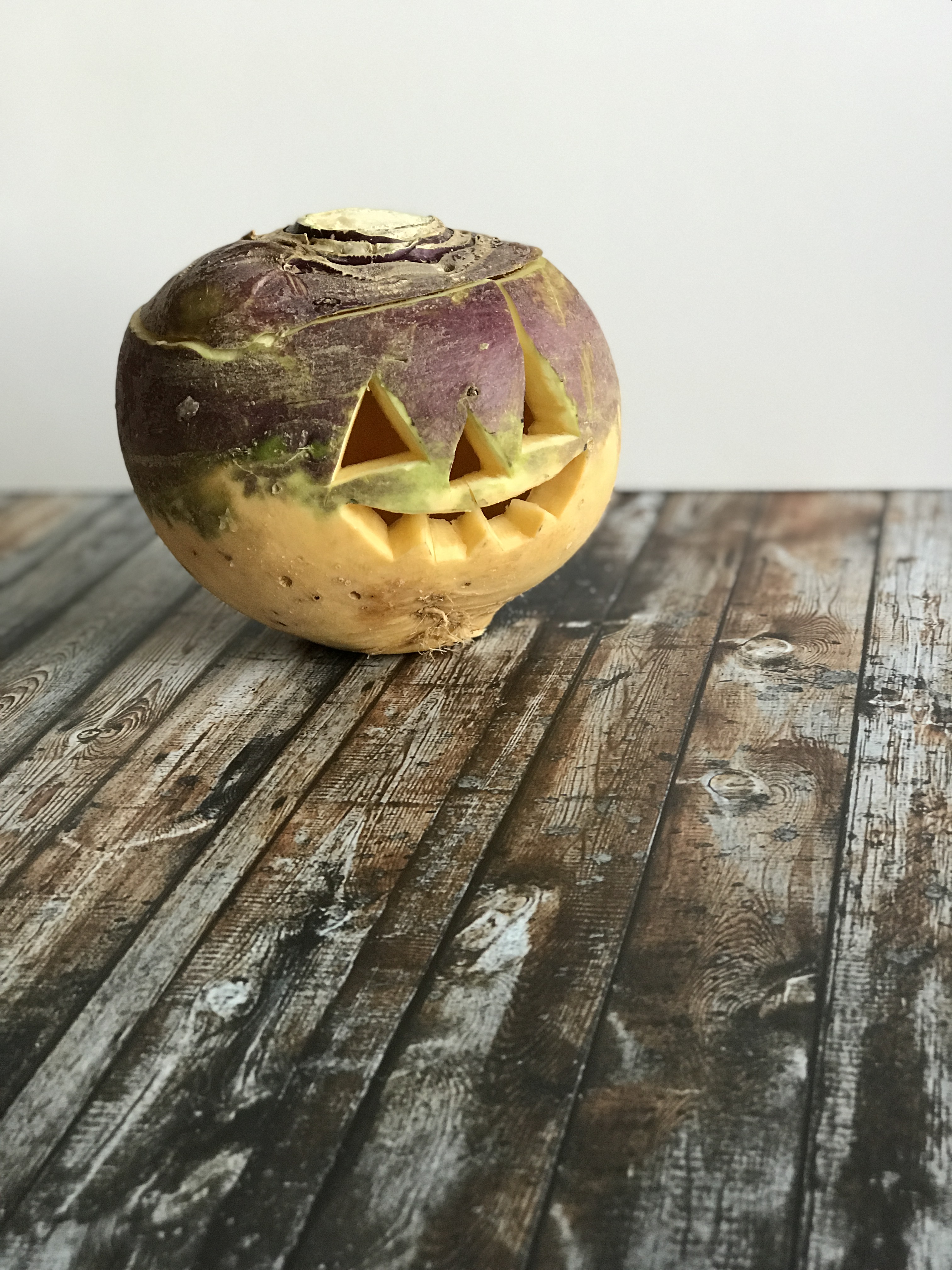
Guising & Turnip Lanterns – Scottish Hallowe’en
I love Hallowe’en! As you can probably tell, from the blog and my Instagram over the last couple of weeks. In Germany, Hallowe’en is not traditionally celebrated. When I went to high school there, is was virtually unknown, though in recent years it has gained in popularity, mostly in the form of a US import, with pumpkins galore and kids going out trick or treating. What many people don’t know, however, is that Hallowe’en isn’t actually an American invention but originates from Ireland and Scotland.

Many of our modern Hallowe’en customs – such as candle lit lanterns and dressing up as supernatural beings – stem from the Celtic celebration of the New Year, which falls on 1st November, Hallowe’en thus being the Celtic New Year’s Eve. The Celtic year is divided into two halves or seasons: a light half and a dark half. The beginning of the Celtic New Year is also the beginning of the dark half of the year and of a new cycle (Beltane, on 1st May, marks the beginning of the light half). Samhain or Samhuinn, as it is called (there are different pronunciations in the various Celtic languages), literally means summer’s end. It is also one of several Celtic fire festivals throughout the calendar year.

Night time was always a time when the veil between the world of the humans and the world of the spirits was considered to be thinner, with Samhain one of the nights in the year when the veil was at its thinnest. It was believed that both spirits and humans were able to pass over the threshold on that night, and traditional folklore holds many tales of spirits returning to visit their kin, and the doors to the ‘fairy realm’ being opened. Far from the Satanic narrative, which many people today cite as a reason for being against the celebration of Hallowe’en, the opposite was in fact the case: customs and rituals were performed to celebrate and thank the gods for a fruitful harvest, to commemorate the dead, and to seek protection from evil spirits for livestock, homes and families throughout the harsh winter months. With the rise of Christianity, Samhain, like many other pagan festivals, was subsumed into Christian customs – Hallowe’en literally means Hallow’s Eve, i.e. the eve of All Hallows Day, or All Saints Day as it is now called. But the old pagan customs didn’t completely die out, and many pagan communities in Scotland still celebrate Samhain in the traditional way, e.g. there is an annual Samhain fire festival held in Edinburgh.

Despite the increasing popularity of Hallowe’en in Germany, it’s been a completely different feeling being back in Edinburgh for Hallowe’en. People don’t tend to go as crazy over their decorations here as they do in the US, but we’ve been enjoying the Hallowe’en window displays around the local shops for weeks. As we get closer to the big night itself, people are starting to put pumpkins in their windows or outside their front doors, to welcome children in search of sweeties. And even though some of the American customs have started to creep in here too – such as the love of pumpkins – we still like to celebrate Hallowe’en a little bit differently in Scotland.
GUISING
In Scotland, instead of trick-or-treating, children used to go guising, disguising themselves in ghoulish costumes so that they could venture out safely among the evil spirits thought to be roaming that night, without being detected. These days you will find children dressed up in almost any costumes – with princesses, pirates and superheroes being popular – but it’s the spooky costumes that still prevail. And guisers couldn’t just knock on people’s doors shouting ‘trick or treat’ and expect to have sweeties just handed over. In Scotland, you don’t get anything for nothing, you need to work hard for your goodies. Children would be expected to perform e.g. a song, poem or joke in return for their sweeties. It’s been almost 30 years since I last went guising in Scotland myself, but I have been told that although kids are increasingly referring to it as ‘Trick or Treat’ here now too, the tradition of guising still prevails under the new name – if you knock on someone’s door on Hallowe’en night, they are likely to look at you expectedly, waiting for you to perform your piece. So the boys have been busying rehearsing their performances. Mr Fox will pull a rabbit out of a hat (an easy trick, thanks to a rabbit-in-a-hat puppet we have but hey, he’s only 2), and Oskar has been busy perfecting his magic trick. We’ve made a little video of it, so that you can have the pleasure of seeing it too. Here it is:
TURNIP LANTERNS
I will be the first to hold up and my hand and say, despite my background as a Scottish folklorist, and being a bit of a traditionalist when it comes to seasonal customs, I welcome the introduction of pumpkins to Scottish Hallowe’en celebrations. You see, traditionally, it was turnips (or neeps, as we like to call them here) that were carved in to ghoulish lanterns, which were then placed near doorways to ward off evil spirits. The custom is said to originate from an Irish folktale about a man named Jack, whose attempt to trick the Devil fails miserably and he is cursed to roam the earth with no more than a piece of burning coal inside a hollowed out turnip. Which is why they are also referred to as ‘jack-o’-lanterns’. However, savvy immigrants, who took this custom to America with them, soon discovered that pumpkins are much, MUCH easier to hollow out and carve. I say this as someone who has plenty of turnip carving related injuries and broken tools to look back on.

HALLOWE’EN GAMES
Whilst these games are not unique to Scotland, I do remember them being a staple of any Hallowe’en party I went to as a child in Edinburgh. Firstly, there was ‘Dookin’ for Apples’, where you had to try and grab an apple floating in a tub of water with your teeth, and without the use of your hands. A variation of this involves kneeling on a chair next to the tub, and trying to pierce one with a fork dropped from between your teeth. Another party game that again prohibited the use of your hands, was trying to eat a treacle scone hanging from a rope. A you can imagine, this was quite a messy game. Especially when paired with the game where you had to try and pick up a coin balanced on top of a mound of flour, with your teeth. Also, actually, without the use of your hands. Hmmm, I see a theme emerging here…

What about you? How do you celebrate Hallowe’en, if at all? Do you think you would fancy a Scottish Hallowe’en? Feel free to share your thoughts in the comments below.







Paula
I’ve learnt so much reading this, thanks! And I loved the magic trick ;-)
Tracy
I’ve heard the same argument not to celebrate Hallowe’en (that it’s something related to satanism) and I think it’s a bit silly! Obviously people don’t know the history of the tradition! In Sweden it is also fairly unusual for kids to go Trick or Treating, although like Germany it is gathering momentum especially with the younger kids!
Beth @ BethinaBox.com
I’m not really a fan of the Americanised Halloween we see. Although, my kids love it. Great post and a fascinating story behind it. :)
Ana De- Jesus
I had no idea that in Germany that Halloween is not usually celebrated who knew!Still at least in Scotland it looks like it is a fun holiday x
Rhian Westbury
I assumed everything came from the States so I had no idea of the origins. Turnip carving doesn’t sound fun though x
suzy Mccullough
Very interesting. I didn’t know. I love your carved pumpkin. We went trick or treating for the first time last night. It was lovely to see all the kids out and about
Fashion and Style Police
Oh I didn’t know Halloween originated from Europe. I thought it was originated from America all this while. Thanks for informing me.
Elizabeth
What a wonderful, informative post! As an expat Canadian I grew up enjoying over the top American style Halloweens. Here in Scotland, well, we’ve got neepie lanterns at least. ;)
Michelle Murray
Oh that has just brought back memories of when we would carve turnips when I was younger
Pingback: 15 Great Hallowe'en Picture Books – The Bear & The Fox
Pingback: How to Carve a Turnip Lantern – The Bear & The Fox
Pingback: Autumn Wish List – The Bear & The Fox